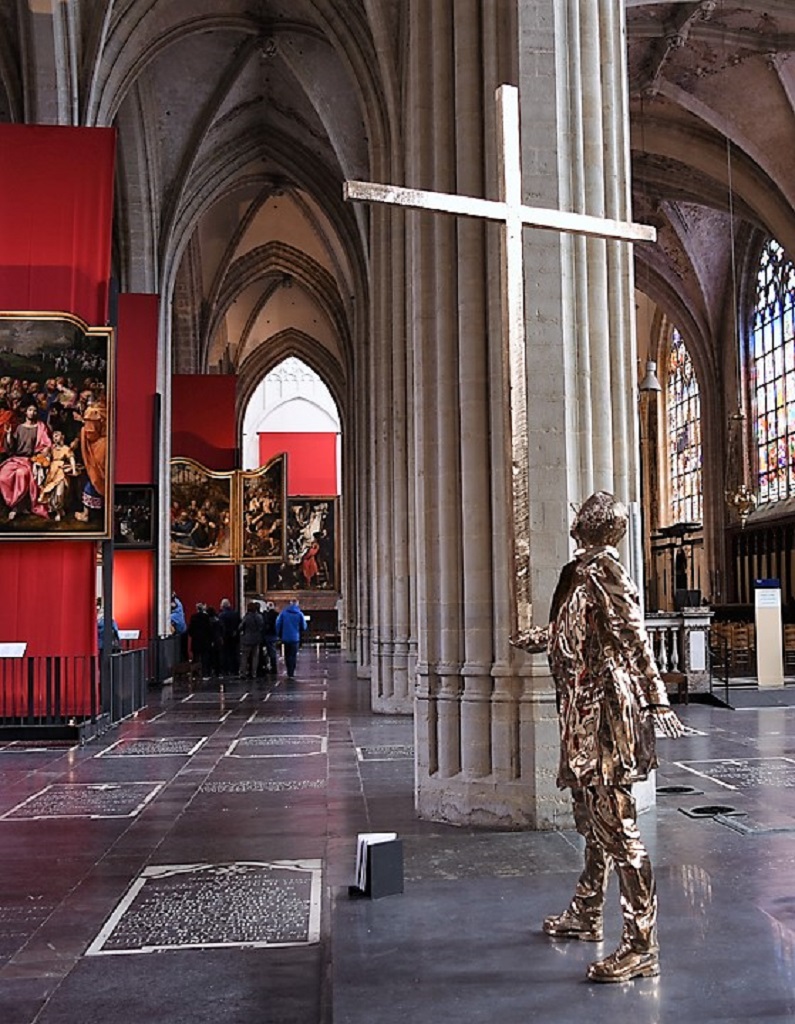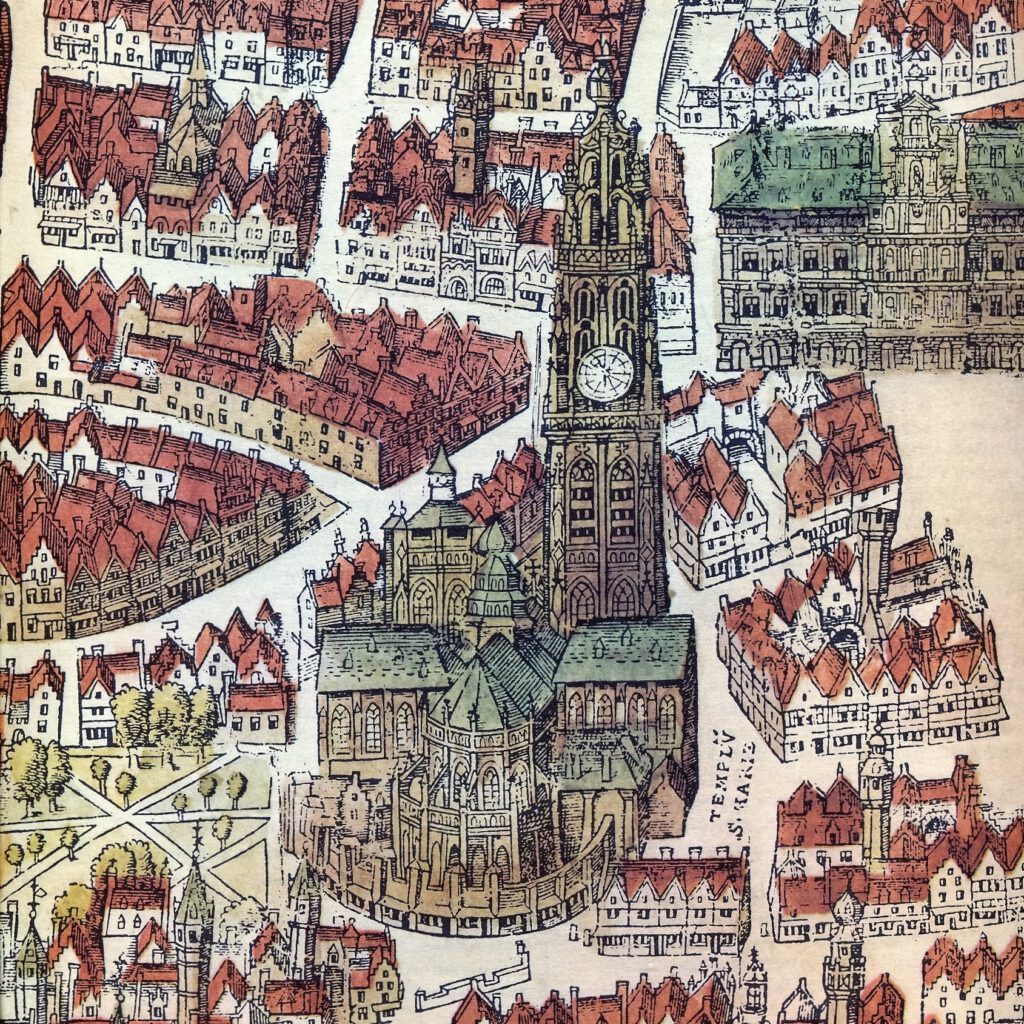The Our Lady’s Cathedral of Antwerp, a revelation.
The man who carries the cross (Jan Fabre)
Thanks to a patron who has given it as a long-term loan, the cathedralThe main church of a diocese, where the bishop’s seat is. again houses a contemporary work of art, since November 2015. The man who carries the cross is a life size statue in polished bronze by the famous multidisciplinary Antwerp artist Jan Fabre. He leaves a mark on contemporary art by using an iconographic language that is either permeated with surrealism in an animist universe, or subdued, nearly dreamlike such as in The man who measures the clouds, high on the roof of De Singel Arts Campus (Antwerp). Also here, in the silence of a cathedral, the face of the artist, who is staring at the cross in full concentration and succeeds in keeping it in balance just yet, reflects as it were a mystical moment. The visitor feels that in this standstill something intense is happening anyway, and is invited to side with the man. As a visitor in this ecclesiastic space you are faced with the religious, transcendent aspects of life. In his or her life each human being is faced with questions that surpass him or her and the question this statue asks is: can you find a balance for these in your life?
Instead of only offering answers, the Church wants to offer space for the vital questions of man. Maybe after all it was not a co-incidence that the pious Thomas More had his search for Utopia (1516) started, not in the then Antwerp stock exchange, but precisely in this church. Even though for modern man it is less obvious to look for this far ideal in faith, still the Church wants to continue stimulating the longing for this pursuit in every human being. On this subject parish priestA priest in charge of a parish. Bart Paepen, who took the initiative for having the statue put here, says: ‘Observe this statue attentively: a man is carrying an enormous wooden cross on his right hand. He is no prophet or apostleThis is the name given to the principal twelve disciples of Jesus, who were sent by Him to preach the gospel. By extension, the term is also used for other preachers, such as the Apostle Paul and Father Damien (“The Apostle of the Lepers”)., no martyrSomeone who refused to renounce his/her faith and was therefore killed. Many martyrs are also saints. or saintThis is a title that the Church bestows on a deceased person who has lived a particularly righteous and faithful life. In the Roman Catholic and Orthodox Church, saints may be venerated (not worshipped). Several saints are also martyrs.. He is someone who in this cathedral does, what we want to invite every visitor to do, regardless of his background or conviction. Hold this cross for a while, sign of God’s love for every human being, sign of the commitment that He asks of his followers. Take the cross and balance it. Possibly you will not succeed in keeping it upright. Maybe it is too heavy or too difficult. Maybe you will have to try it again later. Maybe you find nothing to it and then you can drop it. Who knows, you manage and it feels good. Then it might well be that you have found direction and sense in life.’
Since recently the (further) path of faith can also be read from the liturgical furniture in this cathedral. It starts from the pulpit, the symbol of listening to the word of God. Those who accept the Word, can answer it by adopting faith at the baptismal fontThe stone or metal vessel containing holy water, used for administering baptism. Often the baptismal font is/was located in a specially designed baptistery, usually close to the entrance of the church. on the opposite side. This is what grown-ups do in Easter vigilThe nightly liturgical service on Easter eve. Easter Vigil is the most important religious ceremony. It is the feast of light, the feast of water and the feast of joy for Jesus’s resurrection. During this ceremony the new Easter Candle is blessed.. Then the altarThe altar is the central piece of furniture used in the Eucharist. Originally, an altar used to be a sacrificial table. This fits in with the theological view that Jesus sacrificed himself, through his death on the cross, to redeem mankind, as symbolically depicted in the painting “The Adoration of the Lamb” by the Van Eyck brothers. In modern times the altar is often described as “the table of the Lord”. Here the altar refers to the table at which Jesus and his disciples were seated at the institution of the Eucharist during the Last Supper. Just as Jesus and his disciples did then, the priest and the faithful gather around this table with bread and wine. invites you to meet the living Christ in the EucharistThis is the ritual that is the kernel of Mass, recalling what Jesus did the day before he died on the cross. On the evening of that day, Jesus celebrated the Jewish Passover with his disciples. After the meal, he took bread, broke it and gave it to his disciples, saying, “Take and eat. This is my body.” Then he took the cup of wine, gave it to his disciples and said, “Drink from this. This is my blood.” Then Jesus said, “Do this in remembrance of me.” During the Eucharist, the priest repeats these words while breaking bread [in the form of a host] and holding up the chalice with wine. Through the connection between the broken bread and the “broken” Jesus on the cross, Jesus becomes tangibly present. At the same time, this event reminds us of the mission of every Christian: to be “broken bread” from which others can live.. In this way, this walk, which has started with a question about the cross, gets an answer in the triumphal crossLarge crucifix hanging in the first arch of the choir or chancel. In churches with a rood screen, the triumphal cross usually stands on this. that is floating between the altar and the cupola. On this the man who has carried the cross till the end, shows the way to Divine encounter (suggested by Mary’s assumption high up in the cupola).
Anyway, by putting this statue by Fabre here, for the first time for ages there is a contemporary work of art in this interior. Just as the first builders of this church had foreseen, today’s visitors find a work of art in which they can recognize themselves, which makes them feel welcome and invites them to reflect, so that the cathedral can continue to play its age-old role with verve.
- Our Lady’s Cathedral
- History & Description
- Preface
- Introduction
- Historical context
- A centuries-long building history
- A cathedral never stands alone
- Our Lady’s spire
- The main portal
- Spatial effect
- Mary’s Assumption (C.Schut)
- Erection of the Cross (PP.Rubens)
- Descent of the Cross (PP.Rubens)
- The Resurrection (PP.Rubens)
- Mary’s Assumption (PP.Rubens)
- The high altar
- The collegial choir
- The bishop’s church
- The parish church
- The pulpit
- The confessionals
- Caring for the poor
- The Venerable chapel
- Mary’s chapel
- Corporations and guilds
- The ambulatory
- Funeral monuments
- Praise the Lord!
- Pull all stops: the organs
- Cross-bearer (J.Fabre)
- Bibliography



